From the Editor
Fan Mail
Sled Dogs in His Majesty's Service:
Clark's Eskimo Dogs in World War II
Evolutionary Changes in Domesticated Dogs:
The Broken Covenant of the Wild, Part 3
British Antarctic Survey Sledge Dog
Monument Final Report
Tusaalanga: Learning Inuktitut Online!
In the News
Book Review: The Inuit Thought of It
Tip: Removing Mats
IMHO: The Learning Curve
Index: Volume 11, The Fan Hitch
Navigating
This Site
Index of articles by subject
Index
of back issues by volume number
Search The
Fan Hitch
Articles
to download and print
Ordering
Ken MacRury's Thesis
Our
comprehensive list of resources
Talk
to The Fan
Hitch
The Fan Hitch
home page
ISDI
home page
Editor's/Publisher's Statement
Editor: Sue Hamilton
Webmaster: Mark Hamilton
The Fan Hitch, Journal of
the Inuit Sled Dog, is published four times
a year. It is available at no cost online
at: https://thefanhitch.org.
The Fan Hitch welcomes your letters, stories, comments and suggestions. The editorial staff reserves the right to edit submissions used for publication.
Contents of The Fan Hitch are protected by international copyright laws. No photo, drawing or text may be reproduced in any form without written consent. Webmasters please note: written consent is necessary before linking this site to yours! Please forward requests to Sue Hamilton, 55 Town Line Rd., Harwinton, Connecticut 06791, USA or mail@thefanhitch.org.
This site is dedicated to the Inuit Dog as well as related Inuit culture and traditions. It is also home to The Fan Hitch, Journal of the Inuit Sled Dog.
The Fan Hitch welcomes your letters, stories, comments and suggestions. The editorial staff reserves the right to edit submissions used for publication.
Contents of The Fan Hitch are protected by international copyright laws. No photo, drawing or text may be reproduced in any form without written consent. Webmasters please note: written consent is necessary before linking this site to yours! Please forward requests to Sue Hamilton, 55 Town Line Rd., Harwinton, Connecticut 06791, USA or mail@thefanhitch.org.
This site is dedicated to the Inuit Dog as well as related Inuit culture and traditions. It is also home to The Fan Hitch, Journal of the Inuit Sled Dog.
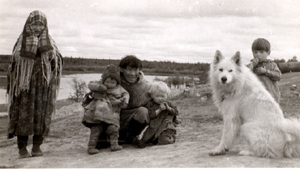
100% authentic Reindeer Herding Dog; on the bank of the
Poluy River, a tributary of the Ob River, south of the Yamul
Peninusla in northwest Russia late July, 1962 V. Beregovoy
Evolutionary Changes in Domesticated Dogs:
The Broken Covenant of the Wild Part 3:
Cultured Breeds and Show-Pet Dogs
by Vladimir Beregovoy
Buchanan, Virginia, USA
Cultured breeds
The appearance of cultured breeds marks the next step in the evolution of the domesticated dog. Every cultured breed was derived and improved by deliberate breeding, at one time or another, from a population of aboriginal dogs. There is no precise data where and when the first cultured breeds originated because it began as a gradual process which started at the dawn of the first civilizations. One major difference between a cultured breed and a primitive one is in the cultured breed’s better adaptation to life under conditions of restricted freedom and under the care and control of people in overcrowded environments. Civilized society needs different dogs, those which are easy to own. This kind of dog is more obedient and submissive even if it is mistreated physically, and it would work anywhere and in any new overcrowded environment. This type of dog lives under the control and care of its master and is his cohort in hunting, sport, guarding or companionship during leisure time. Because cultured breed dogs are kept confined, their breeding in isolation is easy and selection for peculiar appearances and specific working qualities allows the development of numerous breeds, keeping them simultaneously on the same small territory. Importation of dogs with peculiar traits into Europe from different parts of the world added even more peculiar breeds, ones which became absorbed in the process of improving old breeds and developing new ones. As a result of this frequent reshuffling, cultured breeds became more or less genetically cosmopolitan.
Appearance. The earliest signs of impact on dogs caused by esthetic preferences of people are observed in specialized aboriginal breeds, such as different sight hounds and livestock protecting dogs. Short, medium, or long hair coat and pendulous ears of livestock guarding dogs and unusual distribution of long hairs over the body of Afghan Hounds, Taigans and Saluki are examples of considerable differences from Dingo-like dogs. Perhaps lop eared dogs better fit life with nomads who keep livestock on the open plains. Such dogs are less frightening to sheep and they are easier to distinguish from wolves preying on sheep. When it became possible to breed dogs in isolation, dogs' appearance became further diversified. These, and many other differences involving changes in body structure are found in archeological artifacts with images of dogs and fossil remains from ancient Egypt. There were several groups of dogs with conspicuous anatomical differences which can be related to the dachshund, sight hound, greyhound, scent hound and sheep guarding types of dog. Prick eared dogs with almost square body proportions were also there. During the Greco-Roman period of history, six major groups of breeds known today were quite popular: guard dogs, shepherd dogs, bird dogs, scent hounds, sight hounds and toy breeds. Since that time, more breeds within each group and several new type breeds were developed. Differences between the breeds became enhanced, but variation within each breed reduced. Variation of coat colors far exceeds known coat colors among aboriginal breeds and includes also harlequin, mouse blue, chocolate brown, blotched patterns and brindle; none are typical among most known primitive aboriginal breeds. Characteristics in appearance, conducive to the physical function of aboriginal breeds, is not always the case in cultured breeds because esthetic requirements of a purebred looking dog are also important and some features became over exaggerated. For example, long ears and baggy lips of some scent hound breeds.
Reproductive biology. Females of the majority of cultured breeds are good mothers and, under good care, can raise puppies on their own. However, if abandoned, they have estrus periods regardless of the season, usually two times per year, and give birth to large litters, from 9 to 20 or more puppies per litter, which they cannot feed on their own. In feral life, this is very costly energetically and results in high pup mortality. Females of some breeds have false estrus periods, difficulties during parturition and other reproductive problems requiring veterinary assistance.
Behavior. The sixth century and through the eighteenth century was a golden era of diversification of hunting breeds in medieval Europe. Hunting with dogs was a popular pastime. Orderly behavior of dogs during the hunt and around the house was very important and it was a must for dogs of other than hunting purpose as well. Life in a crowded place required obedient and easy to handle dogs. Moreover, during hunting, dogs of each breed were required to act in a certain manner and pursue only a particular kind of game. Thus, scent hounds should use their nose on tracks on the ground when searching and tracking animals, and be persistent and barking continually during the chase. Sight hounds should not use their noses, but search and chase their quarry by eye only. Hounds should be able to live in overcrowded kennels, work well in packs and not fight each other or snarl at unfamiliar people. Guard dogs should be aggressive and mistrustful with unfamiliar people, but also be controllable and obedient to commands. This is now called an "on-and-off dog". Dogs of cultured breeds are easy to teach all kinds of tricks and they are eager to learn, which is now sometimes called a "willing-to-please dog". These and other similar qualities together with peculiar traits of appearance were considered signs of a noble dog and these traits were most coveted and deliberately enhanced by selective breeding. Freedom loving, independent, cautious in unfamiliar surroundings, ceremonious with each other, genetically preprogrammed dogs of primitive breeds were out of place on private estates and in highly ritualized hunts of high status people. They were equally inappropriate in any crowded place, where decisions were made only by people, not by dogs. Cultured breeds displayed discipline and intelligence; they lived and worked in overcrowded environments and, under control of their masters and breeders, achieved amazing perfection such as the cold nose (the ability and desire to track game by using very old, i.e. cold, tracks, sometimes glazed footprints on ice, two or even three days old tracks left by animal on dirt, etc.), the persistence and endurance of scent hounds, the style and beauty of work of bird pointing dogs, the extraordinary intelligence of working with sheep of border collies or police work with Belgian Malinois, German Shepherd Dogs and their mixes. There is no doubt that dogs of functional cultured breeds share fully with their masters the high excitement of their communal pursuit and influence their owners by actively competing with each other. For example, the hunter is watching his dog at work and the dog is stimulated by active participation and encouragement of the hunter by voice, gestures and body language in general, which dogs are so capable to read correctly. The dog may be tired, wet and cold, very hungry and yet he will work, hard driven by that strange excitement. This is how hunter and his dog become one, feel the same and enjoy the same activity. Listening to conversations among hunters with dogs, one can quickly learn that they are much more excited with the style and efficiency of the work of their dogs during the hunt, than with the game the dogs helped them get.
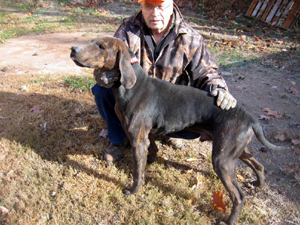
Plott, the American scent hound breed. This Plott belongs
to Charles Montomery, Virginia V. Beregovoy
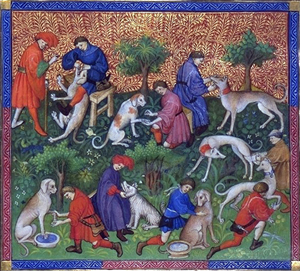
In XV century, artist Gaston Phoebus’ time, dogs were
well cared for. From Gaston Phoebus’ Book of the Hunt,
reprinted with the kind permission of ADEVA, Austria
Show-pet dogs
Show-pet dogs are derived from formerly physically performing cultured or aboriginal breeds. The emergence and expansion of a show-pet culture in the dog loving public signified the most recent step in the evolution of dogs under conditions of life in overcrowded urban society. In Europe and other economically advanced parts of the world, when human population increased, there was little space left for hunters with their dogs. Hunting dogs declined in numbers, but small toy breeds became increasingly popular. Toy breeds, well known from ancient artifacts of old civilizations, had been changed for esthetic purposes first. After a period of decline, hunting dogs made a come back, but in a different capacity. They became show dogs. In effect they joined ranks with toy breeds, becoming big toy breeds for an idle way of life.
In Great Britain, the dog show business was started in 1891 by a young entrepreneur named Charles Cruft. In the United States, the first dog show was held in 1877 by the Westminster Kennel Club. The Westminster Kennel Club was established with a positive view to increase an interest in dogs, and "improving" the breeds. In the beginning good hunting dogs were shown, but when interest in showing dogs became widespread, interest in "purebred" appearance overcame interest in the physical performance of dogs. Breed standards were put together and the standard of each breed became a tool designed to facilitate the work of dog show judges and help breeders to select potential show champions in order to breed even more show champions. Breeders of dogs for show soon discovered that they could do well without using their dogs for hunting, or any other activities, and an assumption that the pedigreed dog was better than dogs without documents became widely accepted. A dog's documents became more important than its functional qualities, the pedigree serving as a stamp of approval, helping breeders of show winning dogs to sell puppies. In fact, for many people, show sport became the sole reason for keeping dogs. Non-hunters assumed the role of experts in hunting breeds and became major producers of puppies. In actuality, their expertise is limited to interpreting a written breed standard, reading literature and talking with other dog owners who never validated their dogs at hunting or other work. Moreover, breed standards were periodically changed. The changes in popular dog breeds are aimed at helping to keep the show sport going. In this context, "improvement" means only the appearance.
Appearance. Show-pet strains retain the same differences between breeds, from which they had been derived, but their appearance has become further changed by reducing variation within one breed and enhancing differences between the breeds in favor of peculiar traits. Some such traits became so-called trademarks of a breed even at the expense of health and functionality, for example the ridge of the Rhodesian Ridgeback, blue eyes of the Siberian Husky, evenly distributed black spots over body of the Dalmatian, stilted joints of the Chow-Chow, wrinkles of the Shar Pei, domed shape of skull of spaniels, long furnishing hair of setters, etc.
Reproductive biology. Physiologically, show-pet strain dogs do not differ much from the breeds from which they originated, but the same and several new problems associated with reproduction increased in frequency. Mating often requires assistance. Some females cannot give birth without veterinary intervention and in extreme cases all females of certain breeds, such as the English Bulldog, can survive the whelping process only if a veterinarian helps by delivering pups via Cesarean section. False estruses in females are recorded in several breeds.
Behavior. Dogs of any particular show-pet strain of any breed are much more variable in behavior than they are in appearance. In general, they are perfectly adapted to idle life in kennels and inside houses or in fenced yards; they are calm and this is very convenient for being controlled by dog show handlers or by veterinarians. Some show strain dogs of different show-pet breeds can be trained to do all kinds of tricks just like those which came from cultured functional breeds, such as spaniels, pointers, retrievers, poodles, etc. There are several activities invented mainly for urbanites, such as lure coursing, weight pulling, agility and retrieving from water. Thus, behavior of some hunting and herding breeds had been modified genetically for lure coursing competitions and herding trials. There are lure coursing dogs and herding trial dogs. A good lure coursing dog has particularly acute reaction to moving objects, live or man-made, stay on the track, not making shortcuts and not detracted by presence of other coursing dogs. For generations, the ability of these dogs to perform their original jobs remained untested. Today, if they are put to work, most of them could not work satisfactorily.
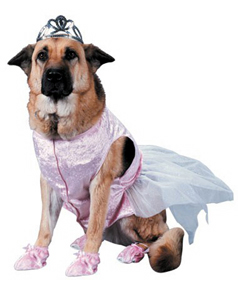
It is highly unlikely that he would be able to terrify
criminals or herd sheep. Courtesy of FunWorld
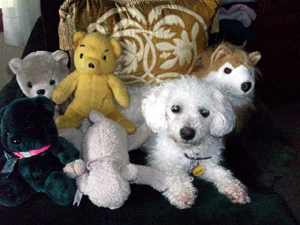
One of these toys actually has a pulse.
L. Murphy
Besides "reputable" show breeders, there are many unscrupulous commercial breeders, known as puppy mills, a kind of dog farming establishment. Such enterprises have dozens and even hundreds of breeding dogs, which live in deplorable conditions. Prior to selling, weaned puppies live in groups sorted by age in wire mesh floor to facilitate the cleaning. The dogs are fed low-grade kibbled dog food to make business cost effective. Commercial breeders do not want visitors, because they know that their operation would not inspire a buyer. They prefer selling by shipping puppies nationwide. Once I had a chance to visit an Airedale Terrier breeder in Tennessee, who advertised in Dog World one year after another. Adult breeding stock dogs lived in about two acre fenced pen that was like a mud pit when it rained. These parents were like a herd of cattle running in one large pen, and their puppies were in cages in one large cattle barn, all sorted in mixed origin groups, by age only, not by litters and the breeder did not have a record of which puppy came from which parents.
Castrating, spaying and other veterinary care and humane methods of euthanasia replace brutal factors of mortality of the past such hanging, shooting, starvation, diseases, predators, etc., but the dogs did not become better because of this. Meaningful evolutionary fate and survival of any breed is determined not by how and why the dogs die, but rather by the quality of the dogs, which survive and procreate. Show-pet breeders are not active dog users, but they are suppliers of puppies and they determine quality of dogs. There is a certain disconnect between the interests of dog breeders and that of dog users, but dog users have little say in the evolution of show-pet dog, unless they breed dogs for themselves and other dog users. If breeders are active dog users and breed their dogs for other dog users, the breed will be functionally sound. There will be always some dogs better then other dogs, but general trend will be towards the functional improvement. If breeders keep dogs idling in pens, the dogs' appearance is the only part which they can know.
There is much money spent on programs involving methods to diagnose debilitating genetic health problems, such as hip dysplasia, with the hope that show-pet breeders could do judicious selection and breed dogs free of genetic problems for their dogs who spend their life in pens and without real working activities. This is not going to help much, because many other genetic deficiencies are lurking and remain unnoticed until the dog is put to work. Besides, every hunter or other working dog user knows that even if a dog would be free of genetic problems, it does not automatically make it a good hunting or working dog.
The accumulation and frequency of genetic health problems in show-pet breeds deserves special attention and research. The dog show fancy is looking for new, "unspoiled" breeds and they adopt "new rescued" breeds for show sport. The older the show strain of aboriginal origin a dog is, the more genetic health problems it has; for example, the Siberian Husky, the Shiba Inu, the Saluki, the Azawakh, the Basenji, the Caucasian Mountain Dog, etc.
While we are overlooking or accepting the disappearance of indigenous aboriginal breeds - those real monuments of nature and ancient culture of functionally sound old type cultured breeds, pop culture show breeds registered and standardized by major kennel clubs are spreading globally like brand name manufactured products, the same in every country of the world, similar to Coca-Cola, Rolls-Royce or Nike sneakers.
The drive and endurance of the working Siberian Husky
combined with various percentages of longer legged/shorter
coated hound and pointer breeds results in a sled dog that excels
in sprint and distance racing. Murphy/MaineMade Dog Sleds
Literature
Gallant, Johan and Edith Gallant. 2008. SOS Dog: The purebred Dog Hobby Re-examined. Alpine Publications.
The Natural History of Inbreeding and Outbreeding. Theoretical and Empirical Perspectives. 1993. Thornhill, Nancy Wilmsen, Editor. The University of Chicago Press. Chicago and London. 575 pp.
Beregovoy, V. H. and J. M. Porter, 2001. Primitive Breeds-Perfect Dogs. Hoflin Publishing. 424 pp.
* *
*
In
part 4 (conclusion): The outlook for primitive and
aboriginal breeds.Correction: In part two (June 2009), the image of the Indog, the primitive aboriginal dog of India, which originally had been attributed to Gautam Das, was actually taken by Bulu Imam who generously granted permission for its use. I apologize to Mr. Imam for the error. Ed.
Vladimir Beregovoy graduated from Perm State University as a biologist in 1960. He defended his dissertation in 1964 and was awarded a Degree of Candidate of Sciences from the Institute of Biology, Uralian Branch of Academy of Sciences of the USSR, where he worked as a zoologist. He taught at the Kuban State University, Krasnodar. During his work as a zoologist, he traveled to Ural, West Siberia, Volga River region, Kazakhstan and North Caucasus.
In 1979, Beregovoy immigrated with his family to Vienna, Austria and in 1980 to Oregon, USA. He worked on series of research projects in North Dakota State University and in 1989 accepted a position as Senior Agriculturist in the Department of Entomology, Oklahoma State University, where he worked until retirement in 2000.
From 1991 to 1996, he imported five West Siberian Laikas, three males and two females, as the foundation stock of this breed, newly introduced in North America. Currently, he is retired and lives with his wife, Emma, and their favorite Laikas on a small, 90-acre farm in Virginia.
Beregovoy has published several articles in popular magazines and two books: Primitive Breeds-Perfect Dogs and Hunting Laika Breeds of Russia. He is also the advisor and curator of the Primitive and Aboriginal Dog Society (PADS) as well as a member of the editorial board of the PADS Newsletter.